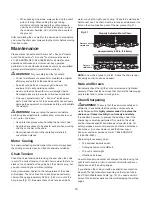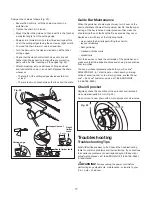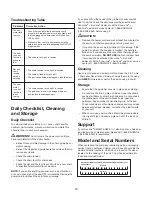
3
spring back and strike the operator, causing severe injury
or death.
•
Do not carry a plugged-in unit. Carry the pole chain saw
from one place to another with the unit unplugged. During
transport, hold the pole at its balance point (close to the
saw end), with the guide bar and chain facing to the rear.
When transporting or storing the pole chain saw, always fit
the guide bar cover.
• Do not cut small brush and saplings with the pole chain
saw. Small branches may catch in the chain and be
whipped towards the operator, which could pull the
operator off balance.
Operating Tips for Chain Saws
• Keep all parts of the body away from the saw chain when
the chain saw is operating. Before you start the chain saw,
make sure the saw chain is not contacting anything. A
moment of inattention while operating the chain saw may
cause entanglement of your clothing or body with the saw
chain.
• Always hold the chain saw with your right hand on the rear
handle and your left hand on the front handle. Holding the
chain saw with a reversed hand configuration increases
the risk of personal injury and should never be done.
• Wear safety glasses and hearing protection. If you are
using the chain saw every day under normal conditions,
you can be exposed to a noise level of 85 dB (A) or higher.
Further protective equipment for head, hands, legs and
feet is recommended. Adequate protective clothing will
reduce personal injury by flying debris or accidental
contact with the saw chain.
• Do not operate the chain saw in a tree. Operation of a
chain saw while up in a tree may result in personal injury.
• Always keep proper footing and operate the chain saw
only when standing on a fixed, secure and level surface.
Slippery or unstable surfaces such as ladders may cause
a loss of balance or control of the chain saw.
•
When cutting a limb that is under tension, be cautious
of spring back. When the tension in the wood fibers is
released, the spring-loaded limb may strike the operator
and/or throw the chain saw out of control.
• Use extreme caution when cutting brush and saplings.
The slender material may catch the saw chain and be
whipped toward you or pull you off balance.
• Carry the chain saw by the front handle with the chain saw
switched off and away from your body. When transporting
or storing the chain saw, always fit the guide bar cover.
Proper handling of the chain saw will reduce the likelihood
of accidental contact with the moving saw chain.
• Follow instructions for lubricating, chain tensioning and
changing accessories. An improperly tensioned or poorly
lubricated chain may either break or increase the chance
for kickback.
•
Keep handles dry, clean and free from oil and grease. Greasy,
oily handles are slippery and can cause loss of control.
• Cut wood only. Do not use the chain saw for any other
purpose. For example, do not use the chain saw to cut
plastic, masonry or non-wood building materials. Using
the chain saw in these incorrect ways could result in
serious damage to you and your tool.
Kickback
m
WARNING!
Kickback may occur when the nose or tip of
the guide bar touches an object, or when the wood closes in
and pinches the saw chain in the cut.
AVOID CONTACTING THE GUIDE BAR TIP WITH ANY
OBJECT.
In some cases, when the tip makes contact with an
object, it may cause a fast reverse reaction, kicking the guide
bar up and back towards the operator. Pinching the saw chain
along the top of the guide bar may also push the guide bar
rapidly back towards the operator. Either of these reactions
may cause you to lose control of the saw, which could result in
serious personal injury.
• When using as a pole chain saw, always use two hands
when operating the pole chain saw, one hand gripping the
trigger and the other hand gripping the pole. Use a firm
grip. Thumbs and fingers must wrap around the trigger
and the pole. When using as a chain saw, maintain a
firm grip (right hand on the rear handle and left hand on
the front handle with thumbs and fingers encircling the
respective handles) and position your body and arms to
allow you to resist kickback forces. Kickback forces can
be controlled by the operator if proper precautions are
taken. Do not let go of the chain saw.
• Keep all guards in place on the machine. Make sure they
are in proper working order.
• Do not overreach. Do not extend arms above shoulder
height when using as a pole chain saw or cut above
shoulder height when using as a chain saw. This helps
prevent unintended tip contact and enables better control
of the unit in unexpected situations.
• Keep solid footing and balance at all times.
• Never try cutting through two branches at the same time.
Only cut one at a time.
• Do not bury the guide bar nose or try to cut by boring the
guide bar nose into the wood.
KICKBACK
DANGER ZONE
Summary of Contents for SUNJOE SWJ807E-RM
Page 22: ...snowjoe com ...





































